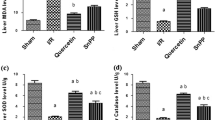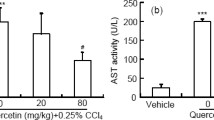Abstract
Flavonoids are reported to exhibit a wide variety of biological effects, including antioxidant and free radical-scavenging activities. Evidence of oxidative reactions is often associated with various chronic disease processes characterized by accumulation of connective tissue. This study was aimed to investigate the protective effects of chronic administration of the flavonoid quercetin (150 μmol/kg body wt/day intraperitoneally) in rats with carbon tetrachloride-induced fibrosis. In animals rendered cirrhotic by administration of carbon tetrachloride for 16 weeks, cell necrosis, fibrosis, and inflammatory infiltration were found. Histological abnormalities were accompanied by a higher hepatic content of collagen and thiobarbituric acid-reactive substances. Expression of inducible nitric oxide synthase (iNOS) was significantly increased in the liver. Treatment with quercetin during 3 weeks improved liver histology and reduced collagen content, iNOS expression, and lipid peroxidation. Those effects were associated with an increased total peroxyl radical-trapping antioxidant capacity of liver. We conclude that quercetin is effective in this model of liver damage.
Similar content being viewed by others
References
Hertog MGL, Hollman PCH: Potential health effects of the dietary flavonol quercetin. Eur J Clin Nutr 50:63-71, 1996
Pace-Asciak CR, Hahn S, Diamandis EP, Soleas G, Goldberg DM: The red wine phenolics trans-resveratrol and quercetin block human platelet aggregation in eicosanoid synthesis: implication for protection against coronary heart disease. Clin Chim Acta 235:207-219, 1995
Jang M, Cai L, Udeani GO, Slowing KV, Thomas CF, Beecher CWW, Fong HH, Farnsworth NR, Kinghorn AD, Mehta RG, Moon RC, Pezzuto JM: Cancer chemopreventive activity of resveratrol, a natural product derived from grapes. Science 275:218-221, 1997
Jovanovic SV, Steenken S, Simic MG, Hara Y: Antioxidant properties of flavonoids: reduction potentials and electron transfer reactions of flavonoid radicals. In Flavonoids in Health and Disease. C Rice Evans, L Packer (eds). New York; Marcel Dekker, 1998, pp 137-161
Manach C, Texier O, Morand C, Crespy V, Regerat V, Demigne C, Remesy C: Comparison of the bioavailability of quercetin and catechin in rats. Free Radic Biol Med 27:1259-1266, 1999
Huk I, Brovkovich V, Nanobash V, Weigel G, Neumayer C, Partyka L, Patton S, Malinski T: Bioflavonoid quercetin scavenges superoxide and increases nitric oxide concentration in ischaemia-reperfusion injury: an experimental study. Br J Surg 85:1080-1085, 1998
Erden Inal M, Kahraman A: The protective effect of flavonol quercetin against ultraviolet A induced oxidative stress in rats. Toxicology 154:21-29, 2000
Duarte J, Galisteo M, Ocete MA, Pérez-Vizcaino F, Zarzuelo A, Tamargo J: Effect of chronic quercetin treatment on hepatic oxidative status in spontaneously hypertensive rats. Mol Cell Biochem 221:155-160, 2001
Wadsworth TL, Koop DR: Effects of Gingko biloba extract (Egb 761) and quercetin on lypopolysaccharide-induced release of nitric oxide. Chem Biol Interact 137:43-58, 2001
Igura K, Ohta T, Kuroda Y, Kaji K: Resveratrol and quercetin inhibit angiogenesis in vitro. Cancer Lett 171:11-16, 2001
Yang K, Lamprecht SA, Liu Y, Shinozaki H, Fan K, Leung D, Newmark H, Steele VE, Kelloff GJ, Lipkin M: Chemoprevention studies of the flavonoids quercetin and rutin in normal and azoxymethane-treated mouse colon. Carcinogenesis 21:1655-1660, 2000
Cao G, Sofic E, Prior RL: Antioxidant and prooxidant behavior of flavonoids: structure-activity relationships. Free Radic Biol Med 22:749-760, 1997
Formica JV, Regelson W: Review of the biology of quercetin and related bioflavonoids. Food Chem Toxic 33:1061-1068, 1995
Iwao K, Tsukamoto I: Quercetin inhibited DNA synthesis and induced apoptosis associated with increase in c-fos mRNA level and the upregulation of p21WAF1C1P1 mRNA and protein expression during liver regeneration after partial hepatectomy. Biochim Biophys Acta 1427:112-120, 1999
Sanders RA, Rauscher FM, WatkiNS JB: Effects of quercetin on antioxidant defense in streptozotocin-induced diabetic rats. J Biochem Mol Toxicol 15:143-149, 2001
Poli G, Parola M: Oxidative damage and fibrogenesis. Free Radic Biol Med 22:287-305, 1997
Parola M, Leonarduzzi G, Robino G, Albano E, Poli G, Dianzani MU: On the role of lipid peroxidation in the pathogenesis of liver damage induced by long-standing cholestasis. Free Radical Biol Med 20:351-359, 1996
Kawada N, Seki S, Inoue M, Kuroki T: Effect of antioxidants, resveratrol, quercetin, and N-acetylcysteine, on the functions of cultured rat hepatic stellate cells and Kupffer cells. Hepatology 27:1265-1274, 1998
Peres W, Tuñón MJ, Mato S, Collado PS, Marroni N, González-Gallego J: Hepatoprotective effects of the flavonoid quercetin in rats with biliary obstruction. J Hepatol 33:742-750, 2000
National Academy of Sciences: The Guiding Principles for Research Involving Animals. Bethesada, Maryland, National Institutes of Health, 1991
Lowry OH, Rosebrough NJ, Farr AL, Randall AJ: Protein measurement with the Folin phenol reagent. J Biol Chem 193:265-275, 1951
Ohkawa H, Ohnishi N, Yagi K: Asssay for lipid peroxides in animal tissues by thiobarbituric acid reaction. Anal Biochem 95:351-358, 1979
Rojkind M, González E: An improved method for determining specific radioactivities of proline 14C and hydroxyproline 14C in collagen and non-collagenous proteins. Anal Biochem 57:1-7, 1974
Evelson P, Travacio M, Repetto M, Escobar J, Llesuy S, Lissi EA: Evaluation of total reactive antioxidant potential (TRAP) of tissue homogenates and their cytososls. Arch Biochem Biophys 388:261-266, 2001
Hernández-Muñoz R, Díaz-Muñoz M, López V, López-Barrera F, Yañez L, Vidrio S, Aranda-Faustro A, Chagoya de Sanchez V: Balance between oxidative damage and proliferative potential in an experimental rat model of CCl4-induced cirrhosis: protective role of adenosine administration. Hepatology 126:1100-1110, 1997
Saperstein LA, Jirtle RL, Farouk M, Thompson HT, Chung KS, Meyers WC: Transforming growth factor-β1 and mannose 6-phosphate/insulin like growth factor-II receptor expression during intrahepatic bile duct hyperplasia and biliary fibrosis in the rat. Hepatology 19:412-417, 1994
Gasso M, Rubio M, Varela G, Cabré M, Caballería J, Alonso E, Deulofem R, Camps J, Giménez A, Pajares M, Parés A, Mato JM, Rodés J: Effects of S-adenosylmethionine on lipid peroxidation and liver fibrogenesis in carbon tetrachloride-induced cirrhosis. J Hepatol 25:200-205, 1996.
Lee KS, Buch M, Houglum K, Chojkier M: Activation of hepatic stellate cells by TGFα and collagen type I is mediated by oxidative stress trough c-myb expression. J Clin Invest 96:2461-2468, 1995
Corrales F, Giménez A, Alvarez L, Caballería J, Pajares MA, Andreu H, Parés A, Mato JM, Rodés J: S-Adenosylmethionine treatment prevents carbon tetrachloride-induced S-adenosylmethionine synthetase inactivation and attenuates liver injury. Hepatology 116:1022-1027, 1992
Castilla-Cortazar I, García M, Muguerza B, Quiroga J, Pérez R, Santidrián S, Prieto J: Hepatoprotective effect of insulin-like growth factor I in rats with carbon tetrachloride-induced cirrhosis. Gastroenterology 113:1682-1691, 1997.
Vendemiale G, Grattagiliano I, Caruso ML, Serviddio G, Valentini AM, Pirrelli M, Altomare E: Increased oxidative stress in dimethylnitrosamine-induced liver fibrosis in the rat: effect of N-acetylcysteine and interpheron alpha. Toxicol Appl Pharmacol 175:130-139, 2001
Polavarapu R, Spitz DR, Sim JE, Follansbee MH, Oberley LW, Rahemtulla A, Nanji AA: Increased lipid peroxidation and impaired antioxidant enzyme function is associated with pathological liver injury in experimental alcoholic liver disease in rats fed diets high in corn oil and fish oil. Hepatology 27:1317-1323, 1998
Ruíz F, Corrales FJ, Miqueo C, Mato J: Nitric oxide inactivates rat hepatic methionine adenosyltransferase in vivo by S-nitrosylation. Hepatology 28:1051-1057, 1998
Szabo C, Billiar TR: Novel roles of nitric oxide in hemorrhagic shock. Shock 12:1-9, 1999
Mayoral P, Criado M, Hidalgo F, Flores O, Arévalo MA, Eleno N, Sanchez-Rodriguez A, Lopez-Novoa JM, Esteller A: Effects of chronic nitric oxide activation or inhibition on early hepatic fibrosis in rats with bile duct ligation. Clin Sci 196:297-305, 1999
Romanska HM, Ikonen TS, Bishop AE, Morris RE, Polak JM: Up-regulation of inducible nitric oxide synthase in fibroblasts parallels the onset and progression of fibrosis in an experimental model of post-transplant obliterative airway disease. J Pathol 191:71-77, 2000
Chen YC, Shen SC, Lee WR, Hou WC, Yang LL, Lee TJ: Inhibition of nitric oxide synthase inhibitors and lypopolysaccharide-induced inducible NOS and cyclooxygenase-2 gene expressions by rutin, quercetin, and quercetin pentaacetate in RAW 264.7 macrophages. J Cell Biochem 82:537-548, 2001
Author information
Authors and Affiliations
Rights and permissions
About this article
Cite this article
Pavanato, A., Tuñón, M.J., Sánchez-Campos, S. et al. Effects of Quercetin on Liver Damage in Rats with Carbon Tetrachloride-Induced Cirrhosis. Dig Dis Sci 48, 824–829 (2003). https://doi.org/10.1023/A:1022869716643
Issue Date:
DOI: https://doi.org/10.1023/A:1022869716643




